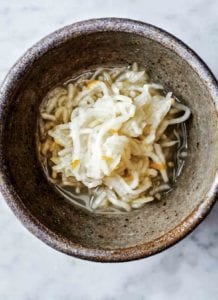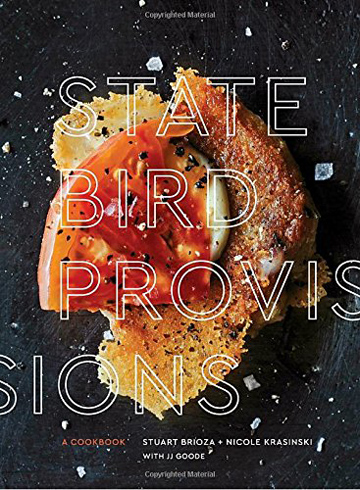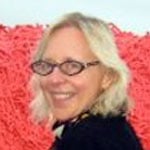
This kohlrabi kraut, similar to traditional cabbage sauerkraut yet with its own unique twist, turns that alien-looking vegetable into something that’s a surprisingly welcome addition to sausages as well as sandwiches or as a simple side.–Angie Zoobkoff
Want to Save This?

Kohlrabi Kraut
Equipment
- 1-to 1 1/2-gallon (3.8-to 5.7-l) fermenting crock with stone weights or a clean 1-gallon glass jar and a 1-gallon resealable bag
Ingredients
- 3 pounds kohlrabi, peeled and grated
- about 1 oz Kosher salt
- 2 teaspoons finely grated Meyer lemon zest
Instructions
- Weigh the prepared kohlrabi. You’ll need 2 percent of this weight of salt. [Editor’s Note: The amount of salt needs to be precisely correlated to the amount of kohlrabi. For 3 lbs (1.4 kg) kohlrabi, you’ll need 1 oz [28 g] salt.]
- In a very large bowl, combine the kohlrabi, salt, and lemon zest. Mix very well with your hands, spending about 5 minutes firmly scrunching, squeezing, and rubbing the mixture together until the kohlrabi is limp and has released a lot of its liquid.
- Transfer the kohlrabi mixture, a handful at a time, to the crock or jar, using your fist to firmly press the mixture after each addition. Pour in any liquid left behind in the bowl. There should be enough liquid to submerge the kohlrabi.
- Add the stone weights or a resealable bag filled with water* to weigh the kraut and keep it submerged. The kohlrabi should be completely submerged. Press down firmly, cover, and seal.
☞ TESTER TIP: If you’re using the jar and resealable bag method for weighing the kraut, you’ll want to fill the bag with a brine solution of 30 grams of salt for every 2 cups water. That way, if your bag leaks, the fermenting kraut won’t be watered down.
- Place the container on a plate to catch any drips in a place that’s approximately 65°F (18°C) and away from direct sunlight. Let ferment for about 10 days, checking every few days to assess the progress. Reweigh the kraut, recover the crock or jar, and continue to ferment until the taste is to your liking.
- Transfer to clean, airtight containers, add enough of the liquid to cover, and store in the fridge for up to 3 months.

Explore More with AI
Nutrition
Nutrition information is automatically calculated, so should only be used as an approximation.
Recipe Testers’ Reviews
I was gifted a generous amount of kohlrabi at a farmer’s market and so I was thrilled to see this kohlrabi kraut recipe pop up. It’s easy to make and produces a gentle and pleasing type of sauerkraut.
I used the glass jar and resealable bag approach. I used a heavy duty bag, but I was still concerned about leakage and so I went ahead and filled the bag with brine instead of water. My grated pieces of kohlrabi were flatter than those pictured in the accompanying photo. I don’t know what the little brown flecks are in the photo either: my kraut was pristinely white. I sought out the Meyer lemons for my zest as specified, but I believe this would be just fine if made with regular lemons.
After sealing, I kept the container in my friend’s root cellar, where the temperature was approximately 65°F and completely away from direct sunlight. When tasting along the way, it was very salty. I could have seen it used as a garnish at that point. It was visually appealing if you like the look of kraut (which I do!), the texture was appealing, and the saltiness I felt would be a nice counterpoint to something otherwise bland for someone who is not always fond of salty foods, which is me! This meant it would have been usable, but not very functional. However, when tasted at a couple of days past the 10-day mark, it wasn’t as salty. This was a plus. It made for a much more usable ferment.
It seemed to need additional lemon, and 2 tablespoons were added. After that, one of my tasters said, “I like it. I will happily eat it. It has a nice fermented flavor and the kohlrabi flavor is subtle.”
This kohlrabi kraut was my first experiment with fermenting but it won’t be my last! The process was simple and the results are fresh, crisp, and have just enough bite to liven up sandwiches, hot dogs and sausages, or serve any place you would use regular cabbage kraut. There is a nice “funky crunch” to the kraut, but the flavor isn’t overwhelming or too salty. A nice addition to the condiment shelf!
I used the food processor to shred the kohlrabi and kosher salt for the brine. By the second day the mixture was giving off a lot of moisture and overflowed the jar a little bit, so keep it on a saucer or in a bowl to capture any mess. By day 8, it was smelling a little sour, and by day 15 I thought it was just right. It’s soured but not fizzy, there is no film or scum on top, and the color is still an appealing creamy white.
I made 1/2 recipe and quantities seem to be in line with recipe. I used a large glass jar and the plastic bag method as the fermenting vessel.
There were no “off” odors and at no point did the kraut look suspicious or unappealing. I don’t know what I was expecting (this struck me as part recipe and part science experiment!).
The results are great and I’ll make it again.
So what if the name of the recipe means “kohlrabi cabbage”? The fermented kohlrabi is crunchy, tart, a tad salty, and the lemon zest actually comes through and adds a delightful accent. This recipe is simple and delivers really outstanding results.
This is as delicious eaten straight from the fridge with a fork (and I’ve been doing that a lot) as it is in a Reuben sandwich.
About 3 weeks after it was done and in the fridge it is still perfectly delicious.











